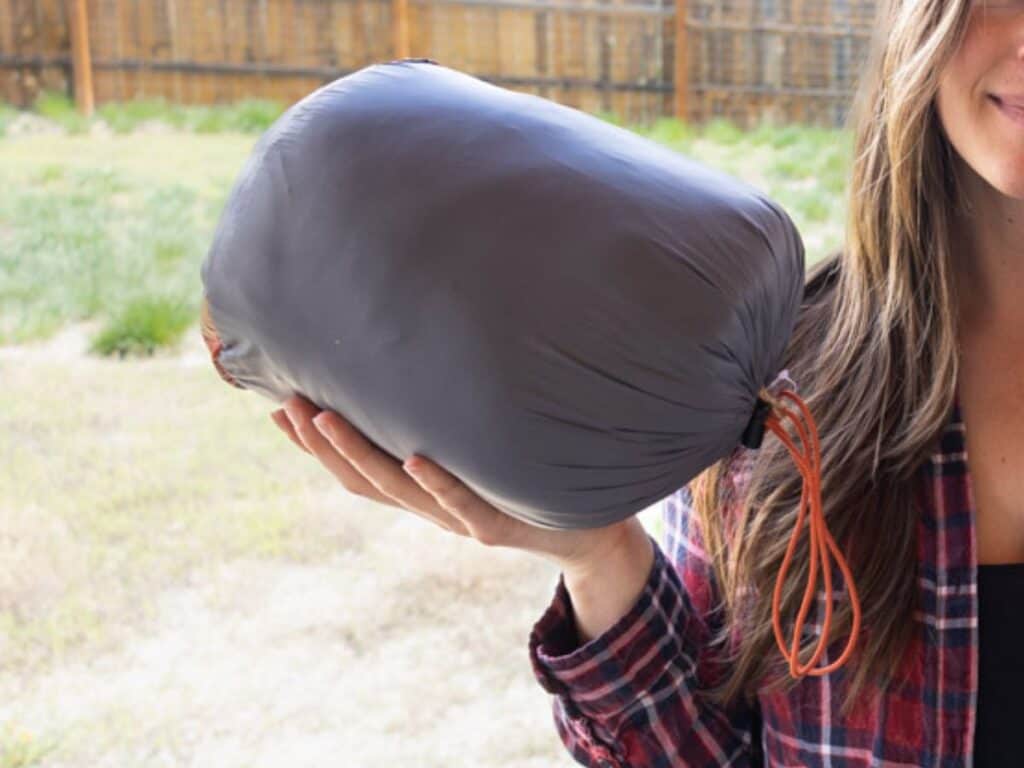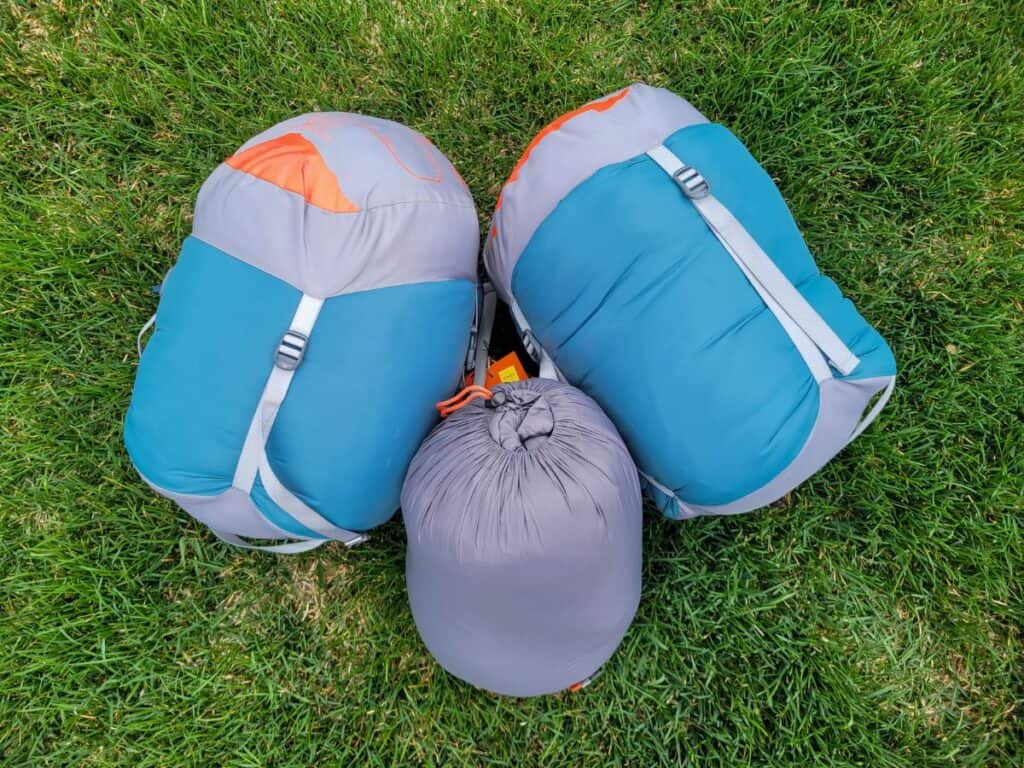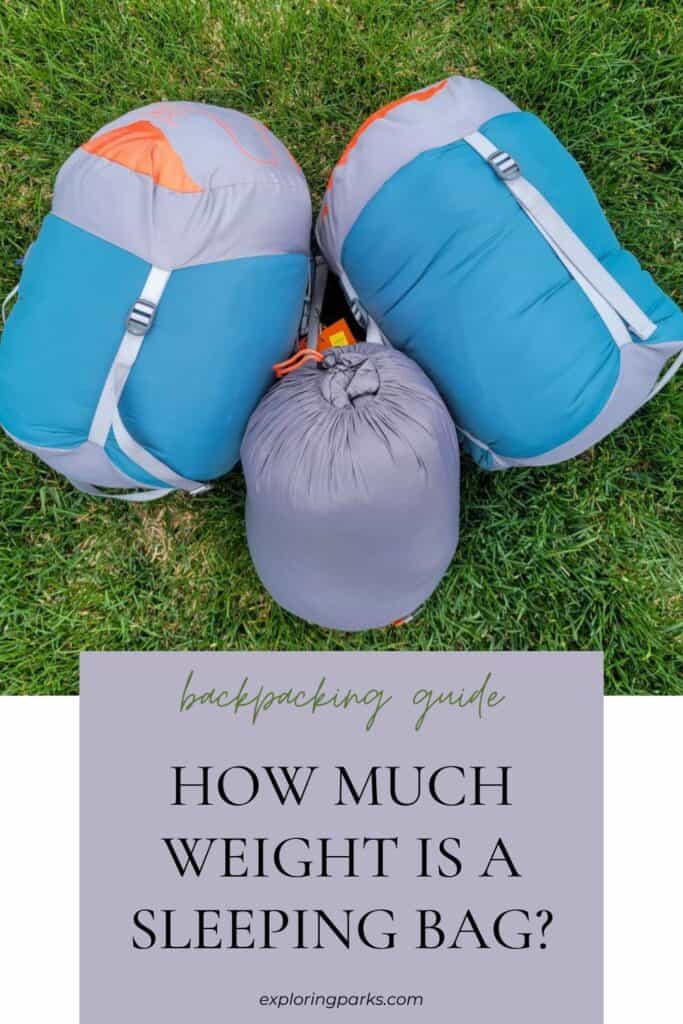How Much Does A Sleeping Bag Weigh For Backpacking?
Having the right sleeping bag for your backpacking trip means having the lowest weight possible based on your needs. How much weight you carry during your backpacking trip can make or break your trip. This guide will give you a better idea about how much a sleeping bag weighs & how to choose the right weight for you.

This page contains affiliate links, which means I make a small commission at no extra cost to you. See full disclosure here.
How Much Does A Sleeping Bag Weigh?
A backpacking sleeping bag should be as little weight as possible. This will ensure that your backpack doesn’t get too heavy for your trip. Your sleeping bag & tent are typically the heaviest items that you will have in your pack.
The weight of an average sleeping bag for backpacking is typically around 2.5 pounds. There are sleeping bags that weigh less, around 1 pound. And there are also sleeping bags that can weigh closer to 5 pounds, depending on the features of the bag.
It is ideal to have a sleeping bag that weighs less than the average 2.5 pounds, but sometimes that might not be possible based on your climate, budget, and other sleeping bag factors. Below, I’ll go over some things to consider which will help you choose the best weighted sleeping bag for your backpacking trip.
What Affects The Weight Of A Sleeping Bag?
There are several factors that can affect the weight of a backpacking sleeping bag. When shopping for a sleeping bag and trying to find the lightest weight, you’ll want to consider:
- Temperature Rating
- Shape of Sleeping Bag
- Type of Insulation
- Sleeping Bag Material
- Sleep System
All of these factors will affect the weight of the sleeping bag. They will also affect the price range of the sleeping bag. You’ll want to ask yourself the following questions to figure out which sleeping bag is the best for your budget.

What Temperature Rating Do I Need?
The temperature rating on a sleeping bag is arguably the most important things to focus on. You want to make sure your bag is the perfect temperature for your camping & backpacking weather condition.
Obviously, the lower the temperature rating is, the more filling (also called “loft”) your sleeping bag will have. The amount of filling in your sleeping bag is a huge factor that affects your sleeping bag weight.
If you live in a typical 4-season climate, then usually a 30-40 degree bag is going to be your best friend. It will keep you comfortable in all three seasons besides winter.
If you live in a bit warmer weather (like Florida or Texas), then you probably want a 40-50 degree sleeping bag to keep you comfortable in the warmer nights of summer. If you happen to camp during cold weather, then you could always add a sleeping bag liner for some extra warmth.
If you live in a colder, mountainous climate, then you probably want to opt for a 10-20 degree sleeping bag. Where we live in Wyoming, even the summer nights are below 40 degrees, so it’s best to prepare for cold nights all year round.
| Climate | Recommended Temperature Rating |
| Moderate 4-Season Climate | 30-40 degrees Fahrenheit |
| Warmer Climate (like Texas or Florida) | 40-50 degrees Fahrenheit |
| Cold or Mountainous Climate | 10-20 degrees Fahrenheit |
Temperature Rating Vs. Comfort Rating
Double check the specs on your sleeping bag when shopping. Sometimes the Temperature Rating is listed instead of the “comfort rating.”
The “temperature rating” is the lowest temperature you can sleep in without causing yourself harm (like hypothermia). The “comfort rating” is the temperature where you can sleep for 8 hours comfortably.
For instance, your sleeping bag might say that it is designed for 30-degree weather, but that is actually the lower limits of the temperature rating, not the comfort rating. This means you won’t be comfortable in 30 degrees, but you’ll survive if you sleep in 30 degrees.

What Shape Of Sleeping Bag Do I Need?
The shape of the sleeping bag will also affect the weight of the bag. I have a post that goes over the differences between a rectangular & mummy style sleeping bag. If you’re backpacking, then the type of sleeping bag you want is definitely going to be a mummy bag.
The mummy bag is designed to contour the shape of your body instead of having extra dead space like a rectangular bag. This keeps your body heat in, which keeps you warmer. The tighter fit also reduces the amount of materials used, which means the bag weighs less.
When looking at lightweight bags, they are almost always mummy shaped. Mummy sleeping bags might not be comfortable if you’re a slide sleeper. If you don’t like sleeping in a mummy-style sleeping bag, then you could look at hoodless sleeping bags or sleeping quilts.
A sleeping quilt is a lighter weight option that can be great for warm weather, but there are also lower temperature rating options. (Check out this that only weighs 1lb 15oz).

What Type Of Sleeping Bag Insulation Do I Need?
The insulation of a sleeping bag is what keeps you at the right temperature.
There are two types of sleeping bag insulations to choose from: Synthetic or Down. Synthetic insulation weighs more than down insulation.
Insulation is one of the areas that you can look at to help the sleeping bag fit into your budget. Down sleeping bags are significantly more expensive than synthetic bags.
If you’re on a tight budget, then synthetic bags might be a better choice because the synthetic fill can keep you just as warm and comfortable. But it will have a little extra weight compared to a sleeping bag with down insulation.
The good news is that a sleeping bag is a long-term investment. With the proper care, your synthetic sleeping bag will most likely last 15 years, and a down bag will last closer to 20 years.

What Material Is A Sleeping Bag Made With?
Most sleeping bags are made with the same types of material, either ripstop nylon or polyester. Both are pretty lightweight materials that are also durable.
It isn’t a huge factor that affects the weight of your bag, but if you want to shave off some extra weight for your sleeping bag, then you might go for a nylon bag opposed to a polyester. Nylon is a little more lightweight, but it is also slightly less durable and holds moisture in a little easier.
Polyester is more durable, but it might add a little extra weight to your bag.
Sleep Systems & Sleeping Bag Weight
The sleep system typically makes up the most weight for ultralight backpackers. A sleep system refers to your sleeping bag, sleeping pad, & pillow. Your tent is another heavier weighted item that you’ll carry in your backpack.
You want to make sure your sleep system is not too heavy, but will also provide the right amount of warmth and comfort for a good night of sleep.
Sleeping pads and sleeping bags go hand in hand. It is really important to choose the right sleeping pad because it will affect the performance of your sleeping bag temperature rating.
Sleeping pads also have a rating, called an “R rating.” The higher the number, the warmer the sleeping pad will keep you while you’re in your sleeping bag.
As you can guess, typically a higher rated sleeping pad means more weight, so choose accordingly.
How To Choose The Best Sleeping Bag Weight?
There are so many options when it comes to shopping for a new sleeping bag.
Choosing a lighter bag is ideal, but it might not be the best option for you. You need to make sure you go through all of the questions above about the right temperature rating, the right shape, & the right material in your sleeping bag. Then, you’ll have a better idea of which sleeping bag is best for you and your budget.
Another thing to consider is the size of the sleeping bag when packed down. Ultra light bags usually pack down easily, but a heavy sleeping bag might not. You can always use a stuff sack to try to compress it, but the size of the sleeping bag needs to fit in your backpack without taking up too much space.

Conclusion
Choosing a sleeping bag can seem complicated when backpacking. It’s important to know how much a sleeping bag weighs so you don’t have too much weight in your backpack. Ideally, your sleeping bag should weigh less than the average 2.5 pounds for your backpacking trip, if possible.
You also need to make sure that your sleeping bag covers all of your needs during your trip. A warmer bag typically means a heavier bag, but might be necessary if you’re sleeping in cold conditions. Choose your sleeping bag according to your conditions and try to save weight where you can based on the temperature rating, shape of the bag, insulation, & materials used.
Related Posts
How Wide Is A Sleeping Bag? (Best Size For You)
How To Wash Dishes While Camping
Camping Essentials That Every Girl Should Bring
Easy DIY Cotton Ball Fire Starters (Long Burning)
How To Stay Warm In A Sleeping Bag
Ultimate Hammock Camping Checklist
How To Use A Camping Stove Indoors (Or In Tent)
How To Choose Hammock vs. Tent Camping

If this is your first time camping, or you need a refresh, then here is a free download for our Basic Camping Packing List. It is a full list of the basic items you need to bring for a successful camping trip.
Our Favorite Camping Gear
Gazelle T4
Hub Tent

Jackery Solar
Generator

Qomotop Self-Inflating Mattress

THERMACELL MOSQUITO REPELLER

